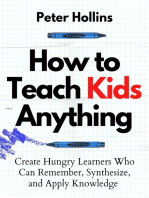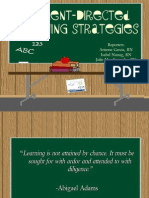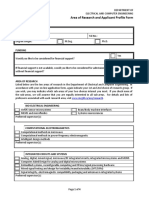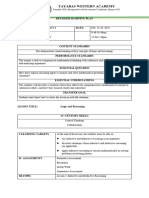0 ratings0% found this document useful (0 votes)
24 viewsLearning Theories Multiple Intelligences
Learning Theories Multiple Intelligences
Uploaded by
Anonymous AFFiZnThe document discusses three learning theories: multiple intelligences theory, behaviorism, and cognitivism. It provides the following key points:
1) Multiple intelligences theory, developed by Howard Gardner, suggests that traditional IQ testing provides too limited a view of intelligence and proposes eight different types of intelligence.
2) Behaviorism views learning as the formation of associations in response to stimuli through reinforcement or punishment. Important behaviorist psychologists include Pavlov, Skinner, and Watson.
3) Cognitivism views learning as the process of mentally constructing new ideas based on prior knowledge and experiences rather than responding to external stimuli. Cognitivists like Piaget focused on different cognitive conditions that impact
Copyright:
© All Rights Reserved
Available Formats
Download as DOCX, PDF, TXT or read online from Scribd
Learning Theories Multiple Intelligences
Learning Theories Multiple Intelligences
Uploaded by
Anonymous AFFiZn0 ratings0% found this document useful (0 votes)
24 views5 pagesThe document discusses three learning theories: multiple intelligences theory, behaviorism, and cognitivism. It provides the following key points:
1) Multiple intelligences theory, developed by Howard Gardner, suggests that traditional IQ testing provides too limited a view of intelligence and proposes eight different types of intelligence.
2) Behaviorism views learning as the formation of associations in response to stimuli through reinforcement or punishment. Important behaviorist psychologists include Pavlov, Skinner, and Watson.
3) Cognitivism views learning as the process of mentally constructing new ideas based on prior knowledge and experiences rather than responding to external stimuli. Cognitivists like Piaget focused on different cognitive conditions that impact
Original Description:
peda
Original Title
3
Copyright
© © All Rights Reserved
Available Formats
DOCX, PDF, TXT or read online from Scribd
Share this document
Did you find this document useful?
Is this content inappropriate?
The document discusses three learning theories: multiple intelligences theory, behaviorism, and cognitivism. It provides the following key points:
1) Multiple intelligences theory, developed by Howard Gardner, suggests that traditional IQ testing provides too limited a view of intelligence and proposes eight different types of intelligence.
2) Behaviorism views learning as the formation of associations in response to stimuli through reinforcement or punishment. Important behaviorist psychologists include Pavlov, Skinner, and Watson.
3) Cognitivism views learning as the process of mentally constructing new ideas based on prior knowledge and experiences rather than responding to external stimuli. Cognitivists like Piaget focused on different cognitive conditions that impact
Copyright:
© All Rights Reserved
Available Formats
Download as DOCX, PDF, TXT or read online from Scribd
Download as docx, pdf, or txt
0 ratings0% found this document useful (0 votes)
24 views5 pagesLearning Theories Multiple Intelligences
Learning Theories Multiple Intelligences
Uploaded by
Anonymous AFFiZnThe document discusses three learning theories: multiple intelligences theory, behaviorism, and cognitivism. It provides the following key points:
1) Multiple intelligences theory, developed by Howard Gardner, suggests that traditional IQ testing provides too limited a view of intelligence and proposes eight different types of intelligence.
2) Behaviorism views learning as the formation of associations in response to stimuli through reinforcement or punishment. Important behaviorist psychologists include Pavlov, Skinner, and Watson.
3) Cognitivism views learning as the process of mentally constructing new ideas based on prior knowledge and experiences rather than responding to external stimuli. Cognitivists like Piaget focused on different cognitive conditions that impact
Copyright:
© All Rights Reserved
Available Formats
Download as DOCX, PDF, TXT or read online from Scribd
Download as docx, pdf, or txt
You are on page 1of 5
Learning theories
Multiple intelligences
The theory of multiple intelligences was developed in 1983 by Dr. Howard Gardner, professor of
education at Harvard University. It suggests that the traditional notion of intelligence, based on
I.Q. testing, is far too limited. Instead, Dr. Gardner proposes eight different intelligences to account
for a broader range of human potential in children and adults.
Howard Gardner defines intelligence as "the capacity to solve problems or to fashion products that
are valued in one or more cultural setting" (Gardner & Hatch, 1989). According to Gardner, 8
different types of intelligence are displayed by humans.
Multiple intelligence(MI) Teacher:
o Is to consider to what extent and in what way MI theory can be applied in an individual
teaching situation within the realistic constraints of objectives, nature of students, time,
space and resources of the classroom.
o Is not only improving second language abilities of his students but contributes to the overall
development of students intelligences.
o Is to create his own MI profile for using it as a guide to designing and reflecting upon his
experience.
o Is curriculum developer, lesson designer and analyst, activity finder or inventor.
MI Learner:
o Is engaged in a process of personality development.
o Is a successful language learner with development of the whole person?
o Is more well -rounded individual with the awareness of his own intelligence and its
working.
o Is in a better position to benefit from instructional approaches and classroom activities.
MI gives the teachers an insight into:
Understanding the differences among the students, their plus points and their abilities.
Understanding the objectives and aims of their teaching and involving the multiple
intelligences of students in accordance with them.
Understanding and devising activities to help develop not only different intelligences
among students but also develop learning through those intelligences.
Teachers should recognize that students bring with them specific and unique strengths
which should be taken into account in classroom situations. Equal attention should be paid
on individuals who show gifts in intelligences other than linguistic and mathematical.
Teachers are to be trained to present their lessons in a wide variety of ways using music,
cooperative learning, art activities, role play, multimedia, field trips, inner reflection, and
much more.
Teachers can have explicit educational goals but they should be willing and able to
approach them by multiple means keeping in mind multiple intelligences. So that their
students are provided with different entry points to learning and given an opportunity to
demonstrate their abilities.
Teacher should try to address each students mind as directly and personally as possible
and try to identify the activities that they frequently use in their classes and categorize them
to see which ones help develop which types of students intelligences.
Behaviorism
Teachers must learn how to teach ... they need only to be taught more effective ways of teaching.
-B. F. Skinner.
Behaviorism assumes that a learner is essentially passive, responding to environmental stimuli.
Believes that a learner starts out with a clean slate, and behavior is shaped by positive and
negative reinforcement.
Positive reinforcement is the application of a stimulus. Negative reinforcement is the
withdrawal of a stimulus.
Important People in Behaviorism
Ivan Pavlov- Did the experiment with the dogs. Came up with the theory of classical
conditioning.
B.F. Skinner- Developed the theory of operant conditioning. Operant Conditioning is the
use of consequences to modify the occurrence and form of behavior.
John B. Watson- The Little Albert experiment. He gets credit for establishing the
psychological school of behaviorism.
Behaviorism and Teachers
Behaviorism is seen when teachers use the following methods:
a. Testing specific skills.
b. More individual work than group learning.
c. Using positive and negative reinforcement.
d. Give the learner immediate feedback.
e. Break down the task into small steps.
f. Repeat the directions as many times as possible.
g. Work from the simplest to the most complex tasks.
h. Give positive reinforcement.
Behaviorism and Students
Students learn through experiences and practices.
Learning is also modified with positive and negative reinforcements.
Students begin to give predicted responses to a stimulus.
Respond to reinforcement.
Pace themselves in an assignment to work from the most basic to the more
complicated concepts.
Ask questions for more clarity in directions
Ask for feedback
Cognitivism
- Learners construct new ideas based on previous knowledge and experiences.
- Cognitive theory defines learning as a semi-permanent change in mental processes or
associations.
- Cognitivists do not require an outward exhibition of learning, but focus more on the internal
processes and connections that take place during learning or Learning results from internal
mental activity and not from externally imposed stimuli.
Teaching and Learning Under the Cognitivist Theory
- Teachers should create an environment with lots of tools for developing an understanding
of the topic. Teachers should monitor students progress and ask lots of questions. Teachers
should provide use visual and verbal teaching methods. Teachers can read aloud to
students. Using technology, they can provide pictures, videos, and charts to enhance
learning (i.e. computer video clip, topic-related images from the web, etc.)
- Students should think deeply and answer questions about the topic to further develop their
understanding. Failure can be a good thing. It helps the student recognize that they need to
learn more to achieve mastery of the topic.
Piaget, Bloom, Bruner, Ausubel are psychologists focused on different cognitive conditions that
impact on learning. E.g. Jean Piaget Constructed models of child development and the learning
process. Identified 4 developmental stages and the cognitive processes associated with each of
them such as:
Sensory-motor - understands his environment through the basic senses
Intuitive /Pre-operational - Thoughts more flexible, memory and imagination begin to
play a part in learning, capable of more creativity.
Concrete Operational Can go beyond the basic information given, but still dependent
on concrete material and examples to support reasoning
Formal Operational Abstract reasoning becomes increasingly possible
Generally, I think that the cognitivist theory is a great theory to follow when teaching. I think that
is always a good idea to provide different ways of learning. Some students are visual learners and
will do better learning through pictures, videos, or visually looking at a text book. Some students
are audio learners and will do better listening to a lecture, or listening to a teacher read aloud to
them. Some students are audio-visual learners and will do better with either technique!
Constructivism
It is an active process in which learners construct the concept or new ideas based on their
current/ past knowledge.
The learner selects and transforms information, constructs hypothesis and make decision.
Encourage students to discover principles.
hands on experiences of physical objects (manipulative learning of objects)
using models and pictures. (make mental images world by learn with brightly colored
pictures)
Use symbol or numbers to teach
You might also like
- Developmental Psychology - The Growth of Mind and Behavior by Frank KeilDocument889 pagesDevelopmental Psychology - The Growth of Mind and Behavior by Frank KeilIgnacio González96% (27)
- Eleot 2.0 ToolDocument2 pagesEleot 2.0 Toolines nouicerNo ratings yet
- The Teacher As Person in The Society PDFDocument55 pagesThe Teacher As Person in The Society PDFJohn Raymond86% (7)
- Ai Questions and AnswersDocument6 pagesAi Questions and AnswersShravan S NairNo ratings yet
- How to Teach Kids Anything: Create Hungry Learners Who Can Remember, Synthesize, and Apply KnowledgeFrom EverandHow to Teach Kids Anything: Create Hungry Learners Who Can Remember, Synthesize, and Apply KnowledgeNo ratings yet
- K To 12 Pedagogical ApproachesDocument109 pagesK To 12 Pedagogical ApproachesDianne Permejo del Prado100% (3)
- Learning - TheoriesDocument31 pagesLearning - TheoriesMckoy SandersonNo ratings yet
- Theories and Practice of Educational ManagementDocument29 pagesTheories and Practice of Educational ManagementJennelyn MaltizoNo ratings yet
- Teaching ApproachesDocument16 pagesTeaching Approachesgabgabb1123zNo ratings yet
- Teaching PreparationDocument69 pagesTeaching PreparationMoe ElNo ratings yet
- Nur Afiqah Binti Ammar 157386Document19 pagesNur Afiqah Binti Ammar 157386Afiqah AmmarNo ratings yet
- Inquiry Based Learning and Its NatureDocument6 pagesInquiry Based Learning and Its NatureOniel FajardoNo ratings yet
- Joseph Bayani Salimbangon Med - Cultural EducationDocument6 pagesJoseph Bayani Salimbangon Med - Cultural EducationJosh SchultzNo ratings yet
- Student Directed Learning StrategiesDocument36 pagesStudent Directed Learning Strategiesyhanne100% (17)
- 1.0 You, The Teacher, As A Person in SocietyDocument53 pages1.0 You, The Teacher, As A Person in SocietyShandee Jeanne Magdaraog100% (2)
- Student Directed Learning StrategiesDocument36 pagesStudent Directed Learning StrategiesSenthil Kumar100% (1)
- Principles of TeachingDocument53 pagesPrinciples of TeachingGlayza Marie ArcillaNo ratings yet
- Chapter 7Document10 pagesChapter 7Luarez, Jessa S.No ratings yet
- Teacher Induction ProgramDocument8 pagesTeacher Induction ProgramRexell MaybuenaNo ratings yet
- Learning TheoriesDocument31 pagesLearning TheoriesGarth GreenNo ratings yet
- Love Your Parents & ProfessionDocument43 pagesLove Your Parents & ProfessionN. SivaNo ratings yet
- LearningDocument21 pagesLearningJ-lou ClarabalNo ratings yet
- Cooperative Learning-Based Approach and Multiple IntelligencesDocument4 pagesCooperative Learning-Based Approach and Multiple Intelligencesred dela cruzNo ratings yet
- Kto12pedagogicalapproaches 150813041950 Lva1 App6892Document109 pagesKto12pedagogicalapproaches 150813041950 Lva1 App6892Sarfraz Ahmed100% (1)
- Methods of Teaching2Document6 pagesMethods of Teaching2Ralph Laurence SevaNo ratings yet
- Pedagogical Sets: Set Test 1Document14 pagesPedagogical Sets: Set Test 1Abdul Rahim ChandioNo ratings yet
- Sci 224: The Teaching of ScienceDocument4 pagesSci 224: The Teaching of ScienceJhoyz GadonNo ratings yet
- Philosophies of EducationDocument44 pagesPhilosophies of EducationGenelyn JamisolaNo ratings yet
- Characteristic of Constructivist Teaching RulesDocument3 pagesCharacteristic of Constructivist Teaching RulesNurul Ain100% (1)
- Dewey's Theory of EducationDocument11 pagesDewey's Theory of EducationJezerelle MendozaNo ratings yet
- Educ 108Document38 pagesEduc 108Jhomela MarcellanaNo ratings yet
- Part III - Approaches in Teaching MathematicsDocument6 pagesPart III - Approaches in Teaching MathematicsCharis VasquezNo ratings yet
- Theories Supporting The Teaching of Physical and Health Education For Elementary GradesDocument10 pagesTheories Supporting The Teaching of Physical and Health Education For Elementary GradesBhebz SagalaNo ratings yet
- Revise English Language Teaching 1Document16 pagesRevise English Language Teaching 1Võ Thị Phương ThơNo ratings yet
- Introduction To Technology For Teaching and LearningDocument41 pagesIntroduction To Technology For Teaching and LearningEunice FernandezNo ratings yet
- Shifu's Philosophy of EducationDocument3 pagesShifu's Philosophy of EducationSumNo ratings yet
- SPPS5Document5 pagesSPPS5steph lapnoliNo ratings yet
- Philosophies of EducationDocument10 pagesPhilosophies of Educationmelchie100% (1)
- L 200 Unit 7Document19 pagesL 200 Unit 7abrokwah sethNo ratings yet
- I Hear and I Forget, I See and I Remember and I Do and I UnderstandDocument36 pagesI Hear and I Forget, I See and I Remember and I Do and I UnderstandHazel Grace Tasarra-VargasNo ratings yet
- LAC Nov. 18,2022 Strategies and Technique in Teaching ScienceDocument31 pagesLAC Nov. 18,2022 Strategies and Technique in Teaching ScienceCharm Vergara100% (1)
- The Integrative Strategies of TeachingDocument22 pagesThe Integrative Strategies of TeachingDan Lhery Susano GregoriousNo ratings yet
- Teaching StrategiesDocument10 pagesTeaching StrategiesLes ChiensNo ratings yet
- Principles of Teaching 1 FinalDocument66 pagesPrinciples of Teaching 1 Finalapi-309214138No ratings yet
- 8601 2Document8 pages8601 2murryNo ratings yet
- Concept Map of The Different Learning Theories With Technology IntegrationDocument1 pageConcept Map of The Different Learning Theories With Technology IntegrationNidia Thomas100% (1)
- Learning TheoriesDocument9 pagesLearning Theorieschafiq jellasNo ratings yet
- ApproachDocument6 pagesApproachMa Yong Rui100% (1)
- Assignment No.1 (Rommel Alonzagay)Document5 pagesAssignment No.1 (Rommel Alonzagay)Rommel Samonte AlonzagayNo ratings yet
- Teori BrunerDocument27 pagesTeori Bruner870622No ratings yet
- Aa Teaching ProfessionDocument7 pagesAa Teaching ProfessionDan ChuiiNo ratings yet
- Cooperative Learning-Based ApproachDocument22 pagesCooperative Learning-Based Approachred dela cruzNo ratings yet
- Strategies For TeachingDocument21 pagesStrategies For TeachingTiktok YouTubeNo ratings yet
- Principles OF TeachingDocument142 pagesPrinciples OF TeachingEimerej C. SpiritNo ratings yet
- FS2Document6 pagesFS2Kyla Mae CayaNo ratings yet
- Week 15 17 Methods and Strategies 20230505175213Document16 pagesWeek 15 17 Methods and Strategies 20230505175213delmoc211No ratings yet
- Principles of Teaching and LearningDocument4 pagesPrinciples of Teaching and Learningnakoda1537No ratings yet
- Teaching StrategiesDocument68 pagesTeaching StrategiesEugene SaldivarNo ratings yet
- Pedagogical Approaches-KTDocument88 pagesPedagogical Approaches-KTJhing HeraNo ratings yet
- Oliva Tle 2Document2 pagesOliva Tle 2arabichindu1No ratings yet
- What Is ConstructivismDocument13 pagesWhat Is ConstructivismNur Wahidah JohariNo ratings yet
- Kisi-Kisi CompreDocument26 pagesKisi-Kisi CompreBelaNo ratings yet
- How To Be a Great Teacher: Your Step-By-Step Guide To Teach Students EffectivelyFrom EverandHow To Be a Great Teacher: Your Step-By-Step Guide To Teach Students EffectivelyNo ratings yet
- Limitations Imposed by RHP Zeros/Poles in Multivariable SystemsDocument6 pagesLimitations Imposed by RHP Zeros/Poles in Multivariable SystemsAnonymous AFFiZnNo ratings yet
- Usage Simulation ManDocument13 pagesUsage Simulation ManAnonymous AFFiZnNo ratings yet
- HW2Document1 pageHW2Anonymous AFFiZnNo ratings yet
- Fuzzy-Pid Based Performance Analysis of DC MotorDocument8 pagesFuzzy-Pid Based Performance Analysis of DC MotorAnonymous AFFiZnNo ratings yet
- HW1Document1 pageHW1Anonymous AFFiZnNo ratings yet
- 10.1007/978 3 642 36321 4Document767 pages10.1007/978 3 642 36321 4Anonymous AFFiZnNo ratings yet
- Course Mat BestDocument2 pagesCourse Mat BestAnonymous AFFiZnNo ratings yet
- 2014 Reconfig TorqueDocument6 pages2014 Reconfig TorqueAnonymous AFFiZnNo ratings yet
- CCOVERDocument1 pageCCOVERAnonymous AFFiZnNo ratings yet
- Decentralized Stochastic Control: Aditya MahajanDocument50 pagesDecentralized Stochastic Control: Aditya MahajanAnonymous AFFiZnNo ratings yet
- EE106b Project Ideas: 1 GuidelinesDocument3 pagesEE106b Project Ideas: 1 GuidelinesAnonymous AFFiZnNo ratings yet
- Dynamics and Control of A 3D Pendulum: Jinglais, Asanyal, Nalin, Dsbaero, NHM @engin - Umich.eduDocument6 pagesDynamics and Control of A 3D Pendulum: Jinglais, Asanyal, Nalin, Dsbaero, NHM @engin - Umich.eduAnonymous AFFiZnNo ratings yet
- Area of Research and Applicant Profile Form: FundingDocument4 pagesArea of Research and Applicant Profile Form: FundingAnonymous AFFiZnNo ratings yet
- Double 3D Pendulum Model Features: - The Lower Body Is An Axially Symmetric Rigid LinkDocument2 pagesDouble 3D Pendulum Model Features: - The Lower Body Is An Axially Symmetric Rigid LinkAnonymous AFFiZnNo ratings yet
- EE106b Project Overview and Rubric: 1 Due DatesDocument3 pagesEE106b Project Overview and Rubric: 1 Due DatesAnonymous AFFiZnNo ratings yet
- SoftwareDocument1 pageSoftwareAnonymous AFFiZnNo ratings yet
- Privacy-Optimal Strategies For Smart Metering Systems With A Rechargeable BatteryDocument51 pagesPrivacy-Optimal Strategies For Smart Metering Systems With A Rechargeable BatteryAnonymous AFFiZnNo ratings yet
- Active Learning: R W RevansDocument3 pagesActive Learning: R W RevansAnonymous AFFiZnNo ratings yet
- Basics 1Document23 pagesBasics 1Tazeentaj MahatNo ratings yet
- AIS Format 2019Document13 pagesAIS Format 2019Peter NgetheNo ratings yet
- Writing ECPEDocument12 pagesWriting ECPEZoeTziavara100% (2)
- Cognitive and Psychosocial of Gifted and TalentedDocument19 pagesCognitive and Psychosocial of Gifted and TalentedvisionNo ratings yet
- 4 - Psychological Foundations of EducationDocument33 pages4 - Psychological Foundations of EducationElvin LlamesNo ratings yet
- MJB Research TarimanDocument19 pagesMJB Research TarimanMariel Suaiso AngelesNo ratings yet
- STP Lesson 3Document2 pagesSTP Lesson 3api-691309810No ratings yet
- Multiple Intelligence TheoryDocument7 pagesMultiple Intelligence TheorykimcheeseNo ratings yet
- How Do Teachers Develop An Understanding of Giftedness: A Qualitative InvestigationDocument130 pagesHow Do Teachers Develop An Understanding of Giftedness: A Qualitative Investigationfrank_davies_5100% (1)
- Silvera Martinussenog Dahl 2001Document8 pagesSilvera Martinussenog Dahl 2001Vandana VashishtNo ratings yet
- Neubauer Freudenthaler 2005 ModelsofEIDocument12 pagesNeubauer Freudenthaler 2005 ModelsofEIhalleyworldNo ratings yet
- Grade 8 LP Inductive and Deducitve ReasoningDocument9 pagesGrade 8 LP Inductive and Deducitve ReasoningRichel CastilloNo ratings yet
- Part A Unit 2 IT SelfManagement SkillsDocument39 pagesPart A Unit 2 IT SelfManagement SkillsJaifray BalwanNo ratings yet
- WebQuests For Inquiry-Based Learning - IntroductionDocument27 pagesWebQuests For Inquiry-Based Learning - IntroductionufotNo ratings yet
- Emotional Intelligence JournalDocument4 pagesEmotional Intelligence JournalabayabayaNo ratings yet
- AI For IndonesiaDocument16 pagesAI For IndonesiaTinesa AriestiNo ratings yet
- TS EAMCET ENGINEERING Top 40 Colleges OU Local Cutoffs - 2023 (For CSE, CSE Specialisations, IT & ECE Courses) - UpdatedDocument11 pagesTS EAMCET ENGINEERING Top 40 Colleges OU Local Cutoffs - 2023 (For CSE, CSE Specialisations, IT & ECE Courses) - Updatedsampandu6479No ratings yet
- Wepik The Future of Artificial Intelligence Predictions and ProjectionsDocument10 pagesWepik The Future of Artificial Intelligence Predictions and ProjectionsVertiqualNo ratings yet
- Activity Proposal PR1, PR2 and Stem DefenseDocument5 pagesActivity Proposal PR1, PR2 and Stem DefenseMary Cielo PadilloNo ratings yet
- Development PlanDocument2 pagesDevelopment PlanRica Claire SerqueñaNo ratings yet
- Piyush KhuranaDocument16 pagesPiyush KhuranaVinay SharmaNo ratings yet
- RrlsDocument5 pagesRrlsshairajsacapanoNo ratings yet
- Complex Problem Solving - A Case For Complex Cognition?Document10 pagesComplex Problem Solving - A Case For Complex Cognition?cyberangel1000No ratings yet
- Plastik Sanatlarda Bir Metafor: KapiDocument92 pagesPlastik Sanatlarda Bir Metafor: KapiEmine ToprakNo ratings yet
- Analyst (Cluj - Russian and English)Document1 pageAnalyst (Cluj - Russian and English)Wenzeslaus MirNo ratings yet
- Chapter 1 - Research Methodology - An IntroductionDocument38 pagesChapter 1 - Research Methodology - An IntroductionNguyễn Khánh MyNo ratings yet
- PDF Handbook of Wise Interventions How Social Psychology Can Help People Change 1St Edition Gregory M Walton Ebook Full ChapterDocument53 pagesPDF Handbook of Wise Interventions How Social Psychology Can Help People Change 1St Edition Gregory M Walton Ebook Full Chapterflorence.loftis441100% (4)











































































































